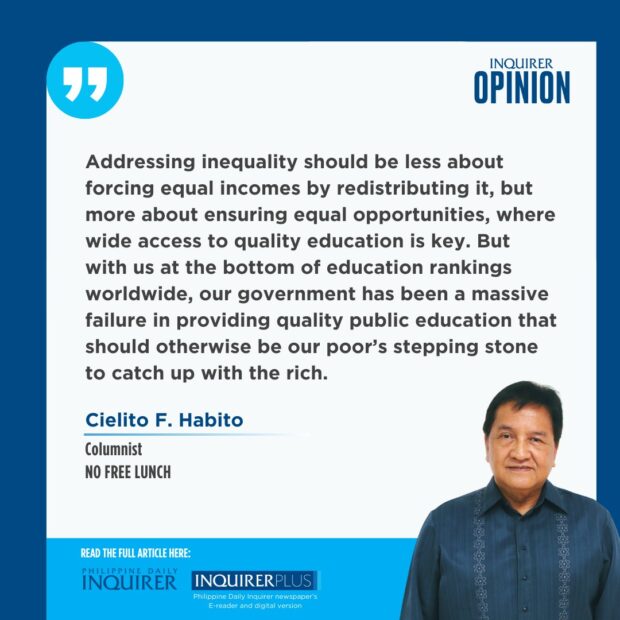
Good news: income distribution in the Philippines appears to have improved. Bad news: even so, we remain the most unequal among our Asean neighbors.
These are based on data on the Gini coefficient, the numerical measure of income inequality that economists use, where 100 means perfect inequality (i.e., the richest individual or family gets all the income) and zero denotes perfect equality (everyone gets exactly the same income). The higher the Gini coefficient, the less equal (or more unequal) income distribution is. In 2015, our Gini coefficient was 44.4, went down to 41.9 in 2018, and down further to 40.6 in 2021. Calculating it is taught in economics or statistics courses, but perhaps a more intuitive measure all could better understand is the simple ratio of the income of the richest decile (one-tenth) of the population to that of the poorest decile. In 2015, the top decile of Filipinos earned 9.1 times what the bottom decile did; the ratio went down to 7.6 in 2018 and was down further to 7 by 2021. These declines are the good news.
The bad news is that we remain among the most, if not the most unequal within Asean, including against Laos and Myanmar, whose Gini coefficients were last measured at 38.8 (in 2018) and 30.7 (in 2017), respectively. The problem is that our economy’s growth had historically been narrow, shallow, and hollow.
“Narrow” means that too few sectors and too few areas of our country drive (hence benefit from) our economy’s growth, which is dominated by large firms owned by either our top billionaires, foreign multinationals, or both, in joint ventures. These drivers have mostly been in services like banking, real estate development, business process outsourcing, and power generation. We could use much more manufacturing, which provides among the best quality jobs for our skilled and lesser skilled workers. Worse, the bulk of these economic activities are concentrated in Metro Manila, Calabarzon, and Central Luzon, which together already account for well over half (57 percent) of the economy’s total output and incomes.
“Shallow” refers to low domestic content and high dependence on imported inputs in many things we produce, best seen in our top export product, electronics. Unknown to many, our top import product is also electronics—the chips that our factory workers assemble into the motherboards and components we export to countries that will turn them into final products that we then import. Our top export products embody but a thin slice of local value added in the form of assembly labor, which means that export growth translates into limited benefit for our domestic economy.
“Hollow” was felt in the phenomenon called “jobless growth” that we often saw in past years, when rapid GDP growth would come with a perverse rise in unemployment, or at best a much smaller growth in employment. Thankfully, this has become less evident in recent years, but a close examination of our employment data shows continuing challenges in the quality of jobs our economy generates.
Faced with all these, there are at least three key pathways to more inclusive growth or one where “the rising tide lifts all boats,” hence reducing inequality: (1) education, society’s supposed “great equalizer;” (2) micro, small, and medium enterprises (MSMEs), which widen participation in and benefits from the economy; and (3) agriculture, the economy’s “backbone” that, unlike services and industry, is prominent in all regions of the country, and whose products are almost entirely of domestic content, making it our most inclusive economic sector. But we seem to be blowing our chances on all three.
Addressing inequality should be less about forcing equal incomes by redistributing it, but more about ensuring equal opportunities, where wide access to quality education is key. But with us at the bottom of education rankings worldwide, our government has been a massive failure in providing quality public education that should otherwise be our poor’s stepping stone to catch up with the rich. MSMEs are key to a more equitable and inclusive economy, and big business need not see them as competing adversaries but as complementary value chain partners. But our governance and financial system continue to make life extremely hard for them, many burdened to death by excessive and cumbersome hurdles imposed by national and local governments and banks. It spans the range from startup registration, to onerous and ever-increasing regulatory, tax, and bank documentation requirements, and even costly closure requirements when the hapless entrepreneur decides to call it quits.
On agriculture, I’ve already published a book of my many writings on what government needs to change. But the more our new agriculture authorities promise change, the more they seem to stay the same—and lately, get even worse. It’s no wonder we’re so unequal.
—————-
cielito.habito@gmail.com